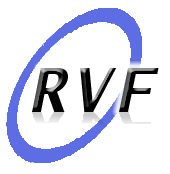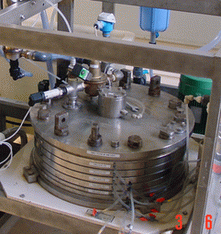
2-in-1 Multi-process membrane systems for lab and industrial tests (21-MPMS series)
Spécifications is here
All-in-one membrane units for lab and industrial tests
(PMS series)
Specifications is here
Industrial installation RVF5-FD-C
Performances of the unit:
1. Used for micro- and ultrafiltration processes
2. Membranes:
- organic, stainless steel and SS-ceramic membranes
- microfiltration membrane’s pore size: 0.1 to 1.5 µm
- ultrafiltration membrane’s MWCO: 1 to 300 kDa
3. Screening of the treated liquid: through 100 – 300 µm SS or organic woven grid screens
4. Range of flow rates (depends on the used membrane): 1.2 – 5.5 m3/day @ 25°C
5. Maximum pressure 6 bar
6. Modes of functioning: manual & automatic
7. Recording all functioning parameter of the process: temperature, pressure, flow rates, membrane’s shear rates, TSS, ...
8. Conditions of the filtration:
- temperature range: 5 to 85°C,
- pressure range: 0.3 to 6 bar,
- treated liquid’s average cross-flow velocity range: 5 to 15 m/s,
- pH range: 2-13
9. Procedures of the filtration:
- Concentration mode: recovery up to 95 % [or volume reduction factor up to 20], desired value of recovery maintains automatically
- Diafiltration (factor of dilution maintains automatically)
- Diafiltration with following concentration (factors of dilution and concentration maintain automatically)
10. Possibility to maintain the following parameters at desired level:
- pH
- concentration of the scale inhibitor
- concentration of the softening agent
- concentration of the biological fouling preventing agents
11. Cleaning in place (CIP): in manual mode (taking into account a low frequency of CIPs).
12. Membranes for replacement are delivered by producer with the backing grid glued to the supporting plate (the used sets “membrane / grid / support plate” have to be returned to the producer’s factory)
13. Materials:
- Frame, filter, tubing, fittings and other equipments are fabricated in 316L stainless steel, electropolished with Ra till 0,8 μm
- EPDM elastomer (viton on request)
14. Power: 400VAC, 50/60Hz, 3-phase, 5 kW
15. Piping nominal diameter (mm):
- Inlet 25
- Permeate outlet 15
- Concentrate outlet 25
16. Approximate overall dimensions (mm):
- Length 1850
- Width 1460
- Height 1730
17. Approximate shipping weight (kg): 500
Applications of the installation RVF5-FD-C include (but not limited to):
- food processing (beverages, brewery: clarification and sterilization)
- dairy
- biopharm




Industrial installation RVF5-E-C
Performances of the unit:
1. Used for nanofiltration and reverse osmosis processes
2. Membranes used:
- organic nanofiltration membrane’s MWCO: 200-1000 Da
- organic reverse osmosis membranes:
i. normal grade
ii. sea water
iii. process grade
iv. low fouling grade, ...
3. Screening of the treated liquid: through 100 – 250 µm SS or organic grid woven screens
4. Range of flow rates (depends on the used membrane and treated liquid properties): 0.7 – 2.2 m3/day @ 25°C
5. Maximum pressure 55 bar
6. Modes of functioning: manual & automatic
7. Recording all functioning parameter of the process: temperature, pressure, flow rates, membrane’s shear rates, conductivity, ...
8. Conditions of the filtration:
- temperature range: 5 to 75°C,
- pressure range: 5 to 55 bar,
- treated liquid’s average cross-flow velocity range: 5 to 15 m/s,
- pH range: 2-12
9. Procedures of the filtration:
- Concentration mode: recovery up to 98 % [or volume reduction factor up to 20], desired value of recovery maintains automatically
10. Possibility to maintain the following parameters at desired level:
- pH
- concentration of the scale inhibitor
- concentration of the softening agent
- concentration of the biological fouling preventing agents
11. Cleaning in place (CIP): in manual mode (taking into account a low frequency of CIPs).
12. Membranes for replacement are delivered by producer with the backing grid glued to the supporting plate (the used sets “membrane / grid / support plate” have to be returned to the producer’s factory)
13. Materials:
- Frame: 304L stainless steel
- Filter and high pressure tubing: 316L stainless steel
- Low pressure tubing: CPVC
- EPDM elastomer
14. Power: 400VAC, 50/60Hz, 3-phase, 4 kW
18. Piping nominal diameter (mm):
- Inlet 25
- Permeate outlet 10
- Concentrate outlet 20
19. Approximate overall dimensions (mm):
- Length 1850
- Width 1460
- Height 1450
20. Approximate shipping weight (kg): 650
Applications of the installation RVF5-E-C include (but not limited to):
- Heavy concentration (volume minimization) of the industrial waste waters which were already concentrated using other techniques (classical dead-end and cross-flow filtration, evaporation, phase separation, etc).
- Dump leachat concentration (volume minimization): rejection of organic polymeric compounds, non-biodegradable COD
- Mineral and synthetic oil emulsions: phase separation and oil concentration
- Cleaning solutions issued from meal working industry: phase separation, oil concentration and cleaning solution recycling
- Dye and polymer containing solution and/or suspensions: phase separation and concentration of organic part
- Waste waters issued from paper mills
- Chemical industry: separation and concentration of the valuable product from water solutions and suspensions


Industrial installation RVF5-U-C
Performances of the unit:
1. Produced for use in environment protecting field
2. Used for micro-, ultra- and nanofiltration processes
3. Membranes used:
- organic, stainless steel and SS-ceramic microfiltration membranes
- microfiltration membrane’s pore size 0.1 to 1.5 µm
- ultrafiltration membrane’s MWCO: 1 to 300 kDa
- organic nanofiltration membranes MWCO: 200-1000 Da
4. Screening of the treated liquid: through 100 – 200 µm SS or organic grid woven screens
5. Range of flow rates (depends on the used membrane and treated liquid properties): 0.7 – 5.5 m3/day @ 25°C
6. Maximum pressure 16 bar
7. Modes of functioning: manual & automatic
8. Recording all functioning parameter of the process: temperature, pressure, flow rates, membrane’s shear rates, TSS, ...
9. Conditions of the filtration:
- temperature range: 5 to 60°C,
- pressure range: 0.5 to 16 bar,
- treated liquid’s average cross-flow velocity range: 2 to 16 m/s,
- pH range: 2-12
10. Procedures of the filtration: concentration mode (recovery up to 95 % [or volume reduction factor up to 20], desired value maintains automatically)
11. Possibility to maintain the following parameters at desired level:
- pH
- concentration of the scale inhibitor
- concentration of the softening agent
- concentration of the biological fouling preventing agents
12. Cleaning in place (CIP): in manual mode (taking into account a low frequency of CIPs).
13. Membranes for replacement are delivered by producer with the backing grid glued to the supporting plate (the used sets “membrane / grid / support plate” have to be returned to the producer’s factory)
14. Materials:
- Frame: 304L stainless steel
- Filter and high pressure tubing: 304L stainless steel
- Low pressure tubing: CPVC
- EPDM elastomer
15. Power: 400VAC, 50/60Hz, 3-phase, 5 kW
16. Piping nominal diameter (mm):
- Inlet 25
- Permeate outlet 10
- Concentrate outlet 20
22. Approximate overall dimensions (mm):
- Length 1600
- Width 1250
- Height 1650
23. Approximate shipping weight (kg): 550



Industrial and laboratory pilote plant RVF4-L-C
Performances of the unit:
1. Four different membranes can be tested simultaneously
2. Four permeate collectors (to collecte the permeate issued from each tested membrane)
3. Concentrate flow can be maintained at a desired level
4. Membranes used:
- organic, stainless steel and SS-ceramic microfiltration membranes
- microfiltration membrane’s pore size 0.1 to 1.5 µm
- ultrafiltration membrane’s MWCO: 1 to 300 kDa
- organic nanofiltration membranes MWCO: 200-1000 Da
5. Screening of the treated liquid: through 100 – 500 µm SS or organic grid woven screens
6. Range of flow rates (depends on the used membrane): 2-7 L/h @ 25°C
7. Maximum pressure 20 bar
8. Modes of functioning: manual & automatic. E&H operator interface and parameter's recorder
9. Recording all functioning parameter of the process: temperature, pressure, flow rates, membrane’s shear rates, conductivity, ...
10. Conditions of the filtration:
- temperature range: 5 to 60°C,
- pressure range: 0.3 to 20 bar,
- treated liquid’s average cross-flow velocity range: 2 to 16 m/s,
- pH range: 1.5-13
11. Procedures of the filtration: concentration mode (recovery up to 95 % [or volume reduction factor up to 20], desired value maintains automatically)
12. Cleaning in place (CIP): in manual mode (taking into account a low frequency of CIPs).
13. Materials:
- Frame: 304L stainless steel
- Filter and high pressure tubing: 316L stainless steel
- Low pressure tubing: CPVC
- EPDM elastomer
14. Power: 230VAC, 50/60Hz, 1.8 kW
15. Piping nominal diameter (mm):
- Inlet 15
- Permeate outlet 8
- Concentrate outlet 10
16. Approximate overall dimensions (mm):
- Length 1350
- Width 550
- Height 1100
17. Approximate shipping weight (kg): 70
Applications of the installation RVF4-L-C include (but not limited to):
- For filterability tests and for the selection of the best membrane
- For preparing the samples of different permeates used for analysis
- For micro-, ultra and nanofiltration



Specifications is here
Specifications is here